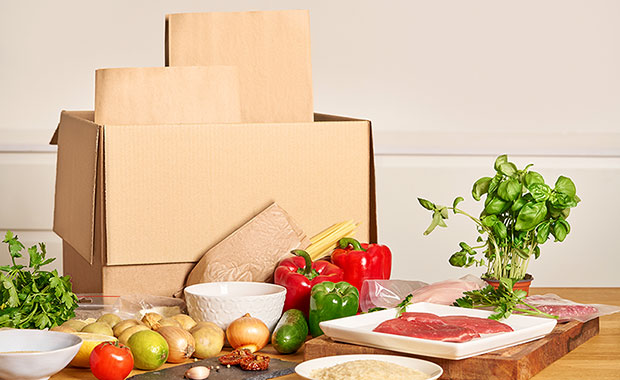Meal kits from services like Blue Apron and Hello Fresh, as well as deliveries from various grocery retailers, are becoming more popular than ever. With people balancing work and home life and often trying to avoid in-person shopping, the convenience and safety of meal kit delivery have made them an increasingly appealing option for many consumers.
The E-Commerce Times caught up with experts in food sales, packaging, and e-commerce to get their takes on the meal kit trend.
“So many families are juggling working from home and navigating distance-learning with children or a new school schedule. The convenience of having a halfway-prepped meal delivered right to your door is appealing, especially when you’re so mentally taxed. The last thing that you want to think about is, ‘What should I cook for dinner?’,” Allison Ball, wholesale consultant and the creator of Retail Ready, explained to the E-Commerce Times.
“Having the decision made of what to cook relieves that mental hurdle that so many folks have. Once that’s alleviated, they have the energy to actually cook the meal,” said Ball.
Meal kit delivery services also limit the amount of time consumers have to spend in grocery stores and restaurants — a benefit that’s become particularly attractive during the pandemic.
“It reduces a trip to the grocery store, or subs in for takeout,” Ball noted. “With COVID-19 still reducing many shoppers’ desire to spend time in a physical grocery store, meal kit deliveries allow consumers to get the benefit of a home-cooked meal without having to do the shopping themselves, order takeout, or navigate the shifting restaurant scene.”
In short, meal kit delivery services make peoples’ lives simpler at a time when daily life has become ever more complex.
“They’re traditionally popular because of the variety and options along with being quick, simple and affordable,” Rich Howard, account executive at Shorr Packaging, told the E-Commerce Times.
“Of course, with everyone doing their best to handle a hectic schedule of work, school and family life at home due to COVID-19, meal kit services allow individuals and families to have a quick, healthy meal via contactless delivery without having to go to the grocery store,” he added.
Catering to Demand
With the growing numbers of meal kit delivery companies comes increased competition. To stand out, these companies must understand the continually shifting needs and desire of their customers.
“There are so many factors that go into having a successful meal kit delivery service,” explained Ball. “You need to really know your audience and ensure that you’re creating meals that they want to buy and are appealing to them.
“Does your audience have dietary restrictions? How big or small is their family? Do they want to do prep or not? Are they comfortable using a stovetop vs. an oven? You’ve got to know your audience and their cooking style so can you develop an offering that they’ll actually purchase.”
Variety, in particular, can be especially important for consumers relying on such services.
“While we all have our favorite classic meals, a wide variety of new and interesting dishes is key to maintaining regular business from your meal kit customers and getting new business through word of mouth,” said Howard. “Trying a new food in a meal kit is almost like an entertainment experience. If you want to be successful, keep things exciting and fresh.”
Incentives can help attract and maintain a customer base in a crowded marketplace.
“To keep existing customers engaged and retain new customers, these companies might offer subscription discounts and incentives to promote their products and express food safety — especially for first-time purchases,” Joe Scioscia, vice president of sales at VAI, an ERP provider in Ronkonkoma, N.Y., told the E-Commerce Times.
“However, it’s important to have marketing initiatives aligned with the entire supply chain to avoid any hiccups in operation that would result in unhappy customers,” he advised.
“For example, meal kits are expected to have the quality ingredients that customers would buy at the grocery store themselves or expect to be served to them in a restaurant.”
Sustainable Packaging
One key trend in the meal kit delivery services is a move toward more sustainable packaging.
“I’m really enthusiastic about the trend of less packaging,” said Ball. “When meal kits really started gaining popularity five-plus years ago, it seemed like every single ingredient came in its own plastic bag, literally: potatoes wrapped in plastic, or 2 tablespoons of lemon juice in a tiny plastic bottle.
“Now we’re seeing meal kits understand that one of the reasons why they were losing consumers was because people were conscious of the waste they generated, so the potatoes come loose in the box, or you get a whole lemon instead of pre-squeezed juice in a plastic vile.
“We’re also seeing companies using reusable delivery boxes or bags and offering to pick up the ice packs for recycling or future use.”
Increasingly, consumers are demanding more of a focus on sustainability and responsibility — both in the packaging and in the food itself.
“There’s an ongoing effort to choose responsibly-sourced food or recyclable packaging materials that is critical both from an environmental standpoint as well as reaching a socially-conscious audience,” said Howard. “It’s all about tailoring your offering to your customers.”
A Look Ahead
As the meal kit delivery industry matures and evolves, special attention must be paid to supply chains, sourcing, and technological infrastructure in order to ensure that deliveries can keep up with demand.
“While it remains to be seen if meal kit popularity increases, steadies, or levels off following a return to a more routine shopping and dining structure, meeting the current changes in demand requires a technological roadmap that should extend beyond e-commerce to engage the entire supply chain,” said Scioscia.
“All aspects of the meal kit supply chain should be aligned to track ingredients and products to ensure the meal kit is fresh when it arrives on a consumer’s doorstep.
“This includes utilizing warehouse management technology specifically designed for food processing and data-driven forecasting to ensure that inventory can keep up with demand. Especially in times of crisis or uncertainty, planning ahead and utilizing predictive technology, such as an analytics solution, can make a huge difference for organizations like meal kit companies who are now seeing an uptick in traffic,” he explained.
Ultimately, meal kit delivery services of the future might be most successful if they see themselves not as a luxury, but as a central component of how food gets bought, delivered, and consumed.
“It’s time to remove the ‘e’ from ‘e-commerce,’ and grocery is an excellent example of this,” Brian Walker, chief strategy officer for Bloomreach, told the E-Commerce Times.
“Commerce no longer needs to be differentiated as online vs. in-store, because at this point, the differentiation is moot for consumers. Meal kit delivery services that recognize the potential to be the sole provider of a family’s food source and act on that potential will see the best results.
“There’s no going back in time, and at this point, consumers are clearly building their lives in a way that makes online grocery delivery a facet of daily life.”














































